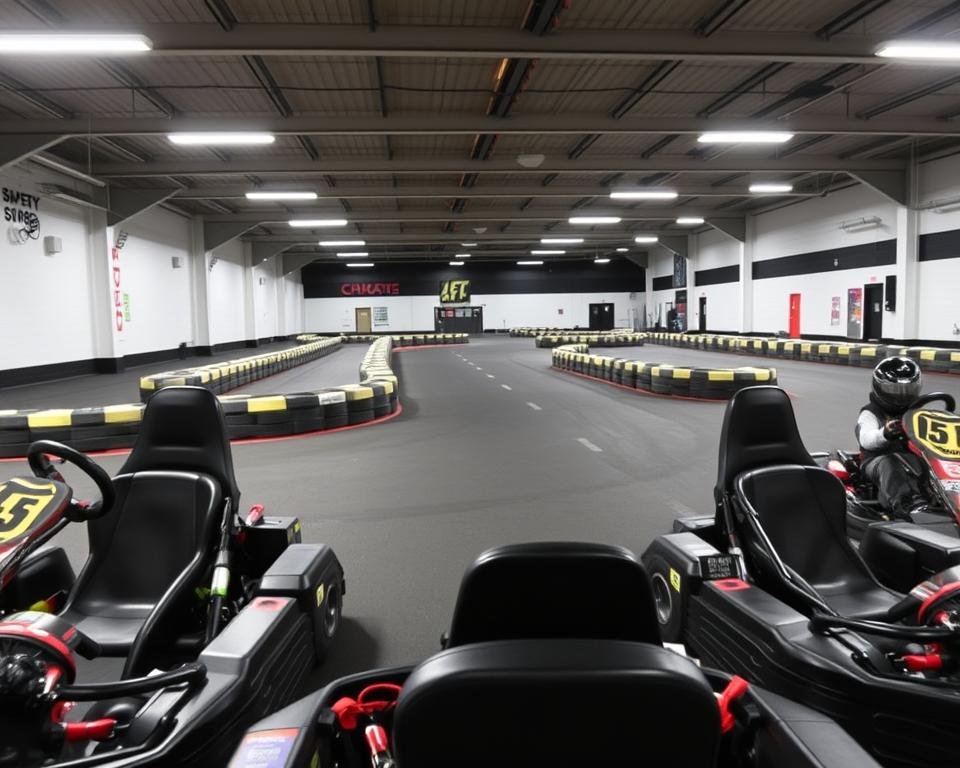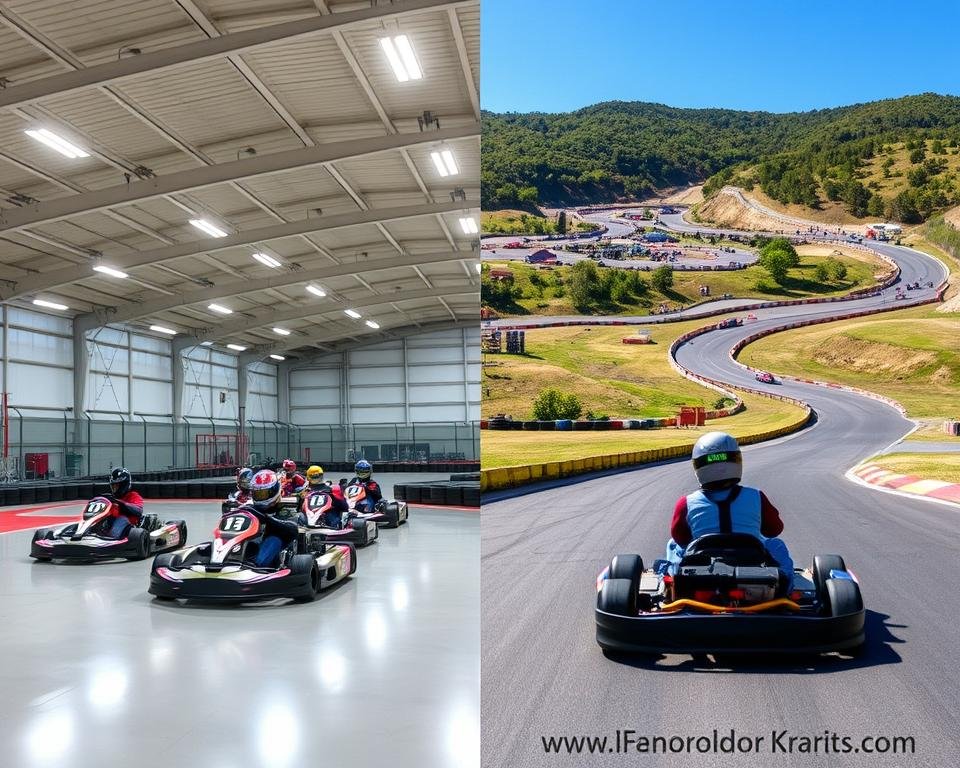Ever wondered why motorsport fans passionately debate track types? Your choice between two popular racing settings shapes everything from skill growth to pure adrenaline. This decision isn’t just about fun—it affects safety, career potential, and how deeply you connect with the sport.
Newcomers often gravitate toward controlled environments, where predictable conditions let you focus on basics. Seasoned racers frequently crave open-air challenges that test reflexes against wind and weather. Each option molds your abilities differently, like how a sculptor chooses clay or marble.
Your goals matter. Casual hobbyists might prioritize convenience, while competitive drivers seek realism. Weather-proof tracks offer year-round access, but natural elements add layers of strategy. Even tire grip changes when sunshine or rain alters the surface.
Why does this divide exist? One group values accessibility; the other thrives on unpredictability. Your preference reveals whether you’re chasing quick thrills or mastering nuanced techniques. This guide helps you match your ambitions to the right asphalt.
Overview of Karting Experiences
Not all tracks are created equal – your asphalt choice shapes skills and thrills. Built environments and natural circuits offer distinct paths for developing speed mastery. This decision impacts everything from lap times to long-term progression in motorsports.
Track Design Shapes Your Experience
Purpose-built facilities prioritize predictable surfaces and climate control. These spaces eliminate rain delays and temperature swings, letting you focus on technique. Smooth concrete and strategic barriers create repeatable conditions ideal for mastering fundamentals.
Natural circuits introduce terrain changes and elevation shifts. A morning drizzle might transform afternoon grip levels completely. You’ll negotiate cracks in asphalt and unexpected debris – elements that mirror professional racing challenges.
Environment Dictates Skill Development
Closed courses help build confidence through consistency. New drivers learn braking points without battling crosswinds. Advanced racers refine precision when every millimeter matters on identical corners.
Open-air tracks demand constant adaptation. Sunshine softens rubber compounds differently than cloud cover. You’ll develop split-second reactions to shifting traction, preparing for real-world racing variables.
Your selection becomes your training partner. Controlled spaces accelerate early growth, while natural settings test refined abilities. Match your environment to current goals – whether chasing personal bests or preparing for competitive events.
Indoor Karting: Safe, Consistent, and Accessible
Rain or shine, climate-controlled circuits remove unpredictability from your racing equation. These facilities prioritize accessibility while sharpening core driving skills through structured challenges.

Controlled Environments and Weather-Proof Racing
Your plans stay intact with tracks operating 365 days a year. No canceled sessions due to storms or heatwaves. Glass-smooth surfaces let you push limits without worrying about potholes or debris.
Consistent grip levels mean lap times reflect skill improvements, not changing asphalt conditions. Air filtration systems maintain ideal temperatures, letting you focus purely on racing lines.
Technical Driving and Safety Features
Twisting layouts demand precise cornering strategies over straight-line speed. You’ll master weight transfer techniques through chicanes while protected by impact-absorbing barriers.
Remote speed governors allow instant intervention if needed. Mandatory helmet protocols and driver briefings create secure spaces for testing boundaries. Many locations now use electric models that balance performance with eco-friendly operation.
Ideal for Beginners and Group Events
Lower-speed karts reduce intimidation for first-timers. Urban locations near transit hubs make coordinating team-building exercises or birthday parties effortless. You’ll find flexible booking options for spontaneous races after work or school.
Structured leagues help newcomers progress systematically. Corporate groups appreciate customizable formats that mix competition with networking opportunities in contained spaces.
Outdoor Karting: Thrills, Speed, and Authentic Racing
Feel the wind whip past as you accelerate into corners where every decision carries real consequences. Open-air circuits deliver raw adrenaline through unfiltered elements and unrestricted performance potential.
High-Speed Driving and Expansive Tracks
Outdoor karts rocket to 80mph, with specialized models hitting 150mph on straightaways. These machines demand respect – their power-to-weight ratios rival entry-level sports cars. You’ll test nerve and precision across mile-long layouts designed for professional events.
Massive plots allow sweeping curves and elevation changes unseen in confined spaces. Strategic overtaking zones let skilled racers exploit drafting techniques. Semi-pro competitions frequently use these tracks, offering pathways to motorsport careers.
Challenging Conditions and Advanced Techniques
Sun-baked asphalt transforms into slippery chaos during sudden showers. You’ll adapt braking points as tire grip fluctuates with temperature shifts. Natural debris like leaves or gravel demands constant visual scanning – distractions indoor venues eliminate.
Mastering wet-weather racing builds championship-level instincts. Advanced karts require throttle modulation to prevent wheel spin on uneven terrain. Each session becomes a puzzle where you balance aggression with calculated risk-taking.
Scenic backdrops enhance the experience, from mountain vistas to coastal stretches. These environments reward those who embrace complexity, turning every lap into a story worth retelling.
Indoor vs. Outdoor Karting: Pros and Cons
Your racing journey hinges on choosing the right battleground. Both environments deliver distinct advantages, but their value depends on your goals and current abilities. Let’s break down how each option shapes your development behind the wheel.
Comparative Analysis of Performance and Challenges
Controlled spaces excel in predictable conditions. Smooth surfaces and climate control let you refine techniques without weather interference. Safety systems like impact barriers and speed governors create low-risk learning zones for mastering fundamentals.
Open-air circuits demand adaptability. Changing grip levels from rain or temperature shifts test reaction times. High-speed straights and elevation changes push machinery to its limits, mirroring professional racing’s unpredictable nature.
Deciding Based on Your Racing Preferences and Skill Level
Newcomers often thrive in structured settings. Urban locations with year-round access simplify scheduling, while lower-speed karts build confidence. Group events benefit from contained layouts that prioritize social interaction alongside competition.
Seasoned racers typically gravitate toward expansive tracks. The raw thrill of 80mph acceleration and natural terrain variations sharpens advanced skills. These environments prepare you for competitive circuits where split-second decisions determine outcomes.
Quality gear remains non-negotiable in either setting. While your choice depends on experience and aspirations, both paths foster growth. Match your environment to where you stand today – and where you want to race tomorrow.
Conclusion
Your next racing adventure awaits – but which path matches your ambitions? Controlled environments provide structured skill-building with predictable surfaces and weather-proof operation. These spaces prioritize safety and accessibility, making them ideal for first-timers or casual group events.
Open-air circuits demand sharper reflexes, where changing terrain and wind patterns test true racing instincts. High-speed challenges here mirror professional motorsport conditions, perfect for honing advanced techniques.
Local facilities often offer both track types, letting you experiment with different styles. Beginners can start with low-pressure sessions before tackling complex courses. Seasoned drivers appreciate how varied conditions push their performance limits.
Whether chasing weekend thrills or competitive goals, your choice shapes growth. Visit nearby venues to discover which environment fuels your passion. Every lap teaches something new – the real win is finding where you thrive.

